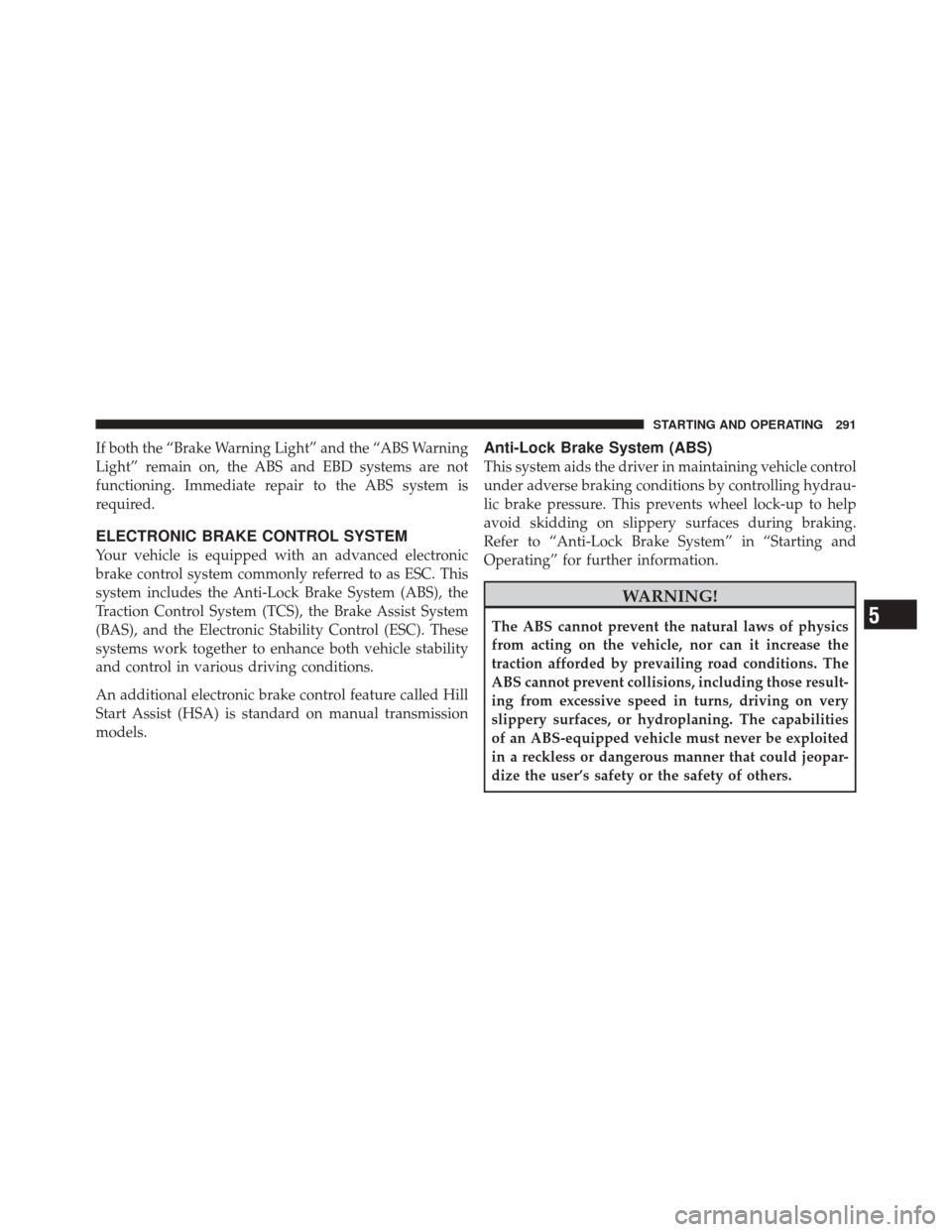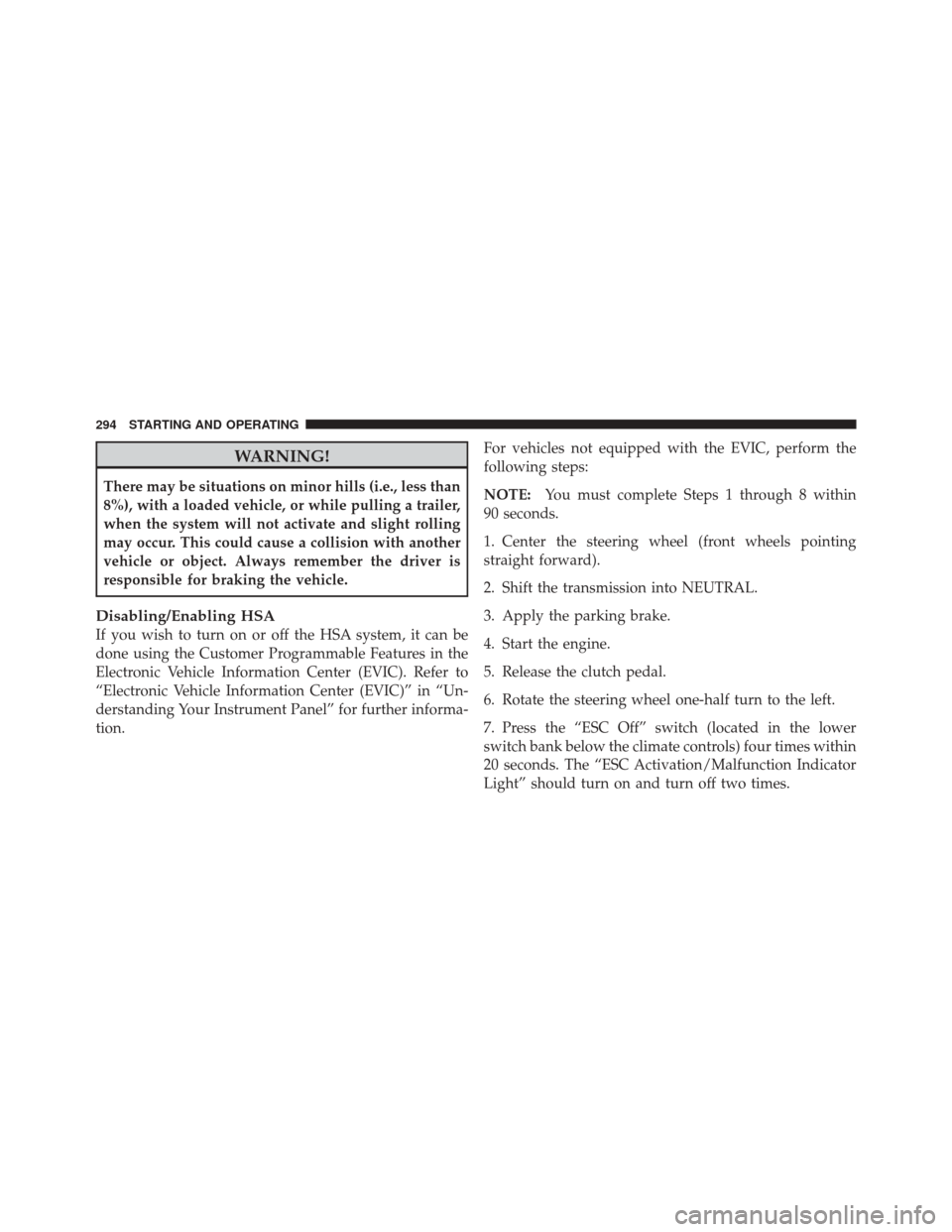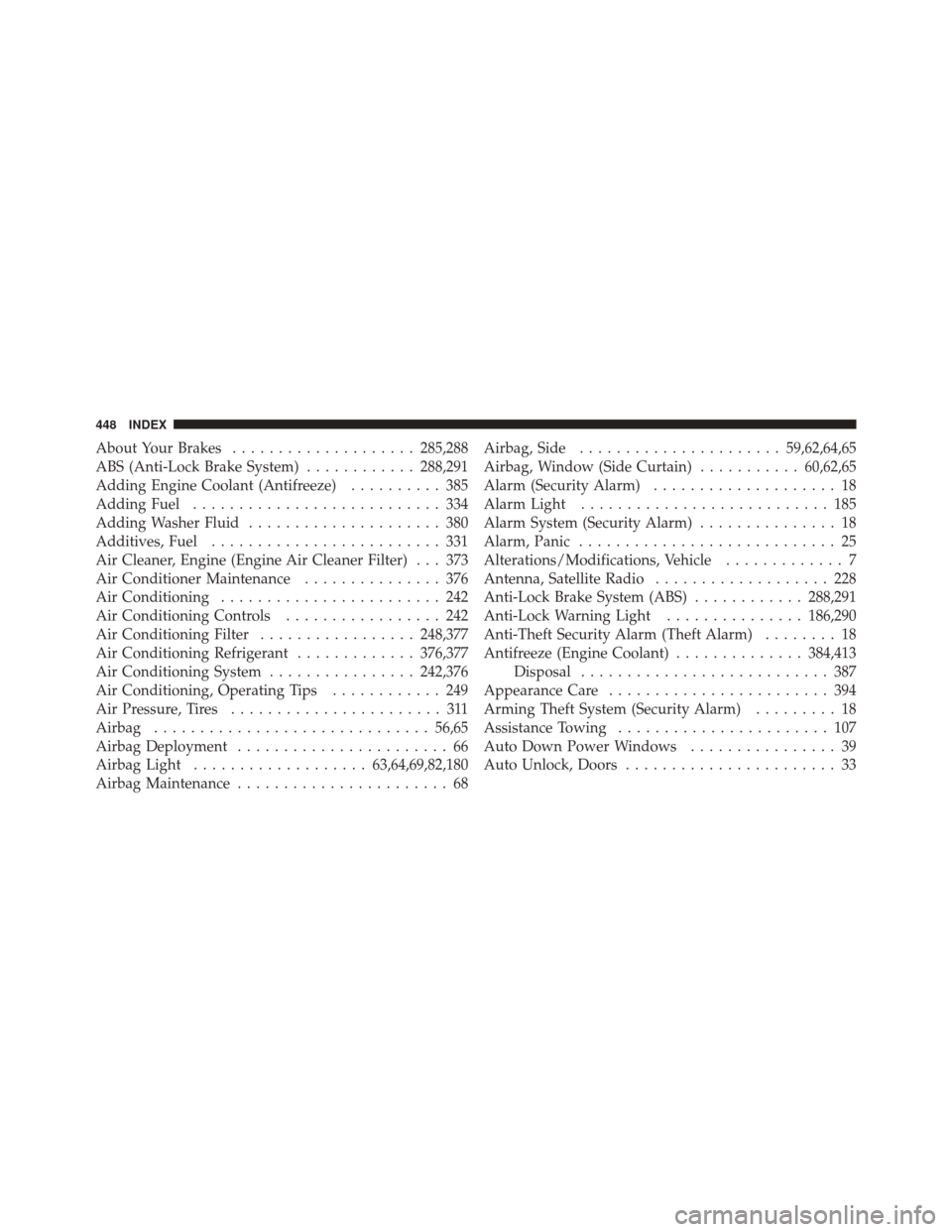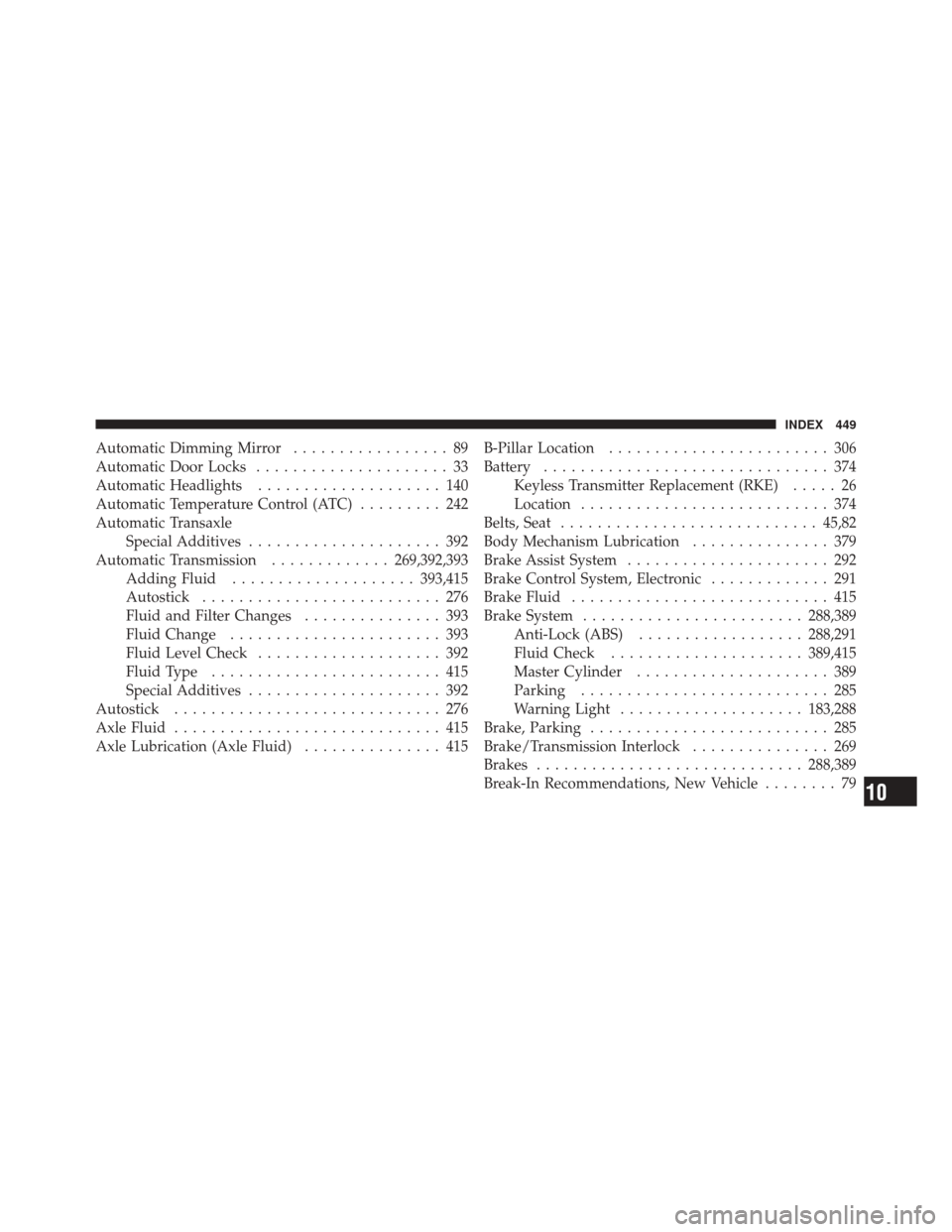2012 DODGE CHALLENGER SRT brake light
[x] Cancel search: brake lightPage 293 of 471

If both the “Brake Warning Light” and the “ABS Warning
Light” remain on, the ABS and EBD systems are not
functioning. Immediate repair to the ABS system is
required.
ELECTRONIC BRAKE CONTROL SYSTEM
Your vehicle is equipped with an advanced electronic
brake control system commonly referred to as ESC. This
system includes the Anti-Lock Brake System (ABS), the
Traction Control System (TCS), the Brake Assist System
(BAS), and the Electronic Stability Control (ESC). These
systems work together to enhance both vehicle stability
and control in various driving conditions.
An additional electronic brake control feature called Hill
Start Assist (HSA) is standard on manual transmission
models.
Anti-Lock Brake System (ABS)
This system aids the driver in maintaining vehicle control
under adverse braking conditions by controlling hydrau-
lic brake pressure. This prevents wheel lock-up to help
avoid skidding on slippery surfaces during braking.
Refer to “Anti-Lock Brake System” in “Starting and
Operating” for further information.
WARNING!
The ABS cannot prevent the natural laws of physics
from acting on the vehicle, nor can it increase the
traction afforded by prevailing road conditions. The
ABS cannot prevent collisions, including those result-
ing from excessive speed in turns, driving on very
slippery surfaces, or hydroplaning. The capabilities
of an ABS-equipped vehicle must never be exploited
in a reckless or dangerous manner that could jeopar-
dize the user’s safety or the safety of others.5
STARTING AND OPERATING 291
Page 296 of 471

WARNING!
There may be situations on minor hills (i.e., less than
8%), with a loaded vehicle, or while pulling a trailer,
when the system will not activate and slight rolling
may occur. This could cause a collision with another
vehicle or object. Always remember the driver is
responsible for braking the vehicle.
Disabling/Enabling HSA
If you wish to turn on or off the HSA system, it can be
done using the Customer Programmable Features in the
Electronic Vehicle Information Center (EVIC). Refer to
“Electronic Vehicle Information Center (EVIC)” in “Un-
derstanding Your Instrument Panel” for further informa-
tion.For vehicles not equipped with the EVIC, perform the
following steps:
NOTE:
You must complete Steps 1 through 8 within
90 seconds.
1. Center the steering wheel (front wheels pointing
straight forward).
2. Shift the transmission into NEUTRAL.
3. Apply the parking brake.
4. Start the engine.
5. Release the clutch pedal.
6. Rotate the steering wheel one-half turn to the left.
7. Press the “ESC Off” switch (located in the lower
switch bank below the climate controls) four times within
20 seconds. The “ESC Activation/Malfunction Indicator
Light” should turn on and turn off two times.
294 STARTING AND OPERATING
Page 297 of 471

8. Rotate the steering wheel back to center and then an
additional half-turn to the right.
9. Turn the ignition switch to the OFF position and then
back to the ON position. If the sequence was completed
properly, the “ESC Activation/Malfunction Indicator
Light” will blink several times to confirm HSA is dis-
abled.
10. Repeat these steps if you want to return this feature
to it’s previous setting.
Electronic Stability Control (ESC)
This system enhances directional control and stability of
the vehicle under various driving conditions. The ESC
corrects for oversteering and understeering the vehicle
by applying the brake of the appropriate wheel. Engine
power may also be reduced to assist in counteracting the
condition of oversteer or understeer and help the vehicle
maintain the desired path.The ESC uses sensors in the vehicle to determine the path
that the driver intends to steer the vehicle and compares
it to the actual path of the vehicle. When the actual path
does not match the intended path, the ESC applies the
brake of the appropriate wheel to assist in counteracting
the condition of oversteer or understeer.
•Oversteer - when the vehicle is turning more than
appropriate for the steering wheel position.
•Understeer - when the vehicle is turning less than
appropriate for the steering wheel position.5
STARTING AND OPERATING 295
Page 391 of 471

Brake System
In order to assure brake system performance, all brake
system components should be inspected periodically.
Refer to the “Maintenance Schedule” for the proper
maintenance intervals.
WARNING!
Riding the brakes can lead to brake failure and
possibly a collision. Driving with your foot resting or
riding on the brake pedal can result in abnormally
high brake temperatures, excessive lining wear, and
possible brake damage. You would not have your full
braking capacity in an emergency.
Master Cylinder – Brake Fluid Level Check
Check the fluid level in the master cylinder immediately
if the “Brake Warning Light” indicates system failure.
Check the fluid level in the master cylinder when per-
forming underhood services.
Clean the top of the master cylinder area before removing
the cap. Add fluid to bring the level up to the “MAX”
mark on the side of the master cylinder reservoir.
Overfilling of fluid is not recommended because it may
cause leaking in the system.
Add enough fluid to bring the level up to the require-
ments described on the brake fluid reservoir. With disc
brakes, fluid level can be expected to fall as the brake
pads wear. However, low fluid level may be caused by a
leak and a checkup may be needed.
7
MAINTAINING YOUR VEHICLE 389
Page 422 of 471

Once a Month
•Check tire pressure and look for unusual wear or
damage.
•Inspect the battery, and clean and tighten the terminals
as required.
•Check the fluid levels of the coolant reservoir, brake
master cylinder, and power steering, and add as
needed.
•Check all lights and other electrical items for correct
operation.At Each Oil Change
•Change the engine oil filter.
•Inspect the brake hoses and lines.
CAUTION!
Failure to perform the required maintenance items
may result in damage to the vehicle.
Required Maintenance Intervals
Refer to the Maintenance Schedules on the following
pages for the required maintenance intervals.
8
M
A I
N T
E
N A
N CE
S
C
H E
D
U L
E
S420 MAINTENANCE SCHEDULES
Page 450 of 471

About Your Brakes.................... 285,288
ABS (Anti-Lock Brake System) ............288,291
Adding Engine Coolant (Antifreeze) .......... 385
Adding Fuel ........................... 334
Adding Washer Fluid ..................... 380
Additives, Fuel ......................... 331
Air Cleaner, Engine (Engine Air Cleaner Filter) . . . 373
Air Conditioner Maintenance ............... 376
Air Conditioning ........................ 242
Air Conditioning Controls ................. 242
Air Conditioning Filter .................248,377
Air Conditioning Refrigerant .............376,377
Air Conditioning System ................242,376
Air Conditioning, Operating Tips ............ 249
Air Pressure, Tires ....................... 311
Airbag .............................. 56,65
Airbag Deployment ....................... 66
Airbag Light ................... 63,64,69,82,180
Airbag Maintenance ....................... 68 Airbag, Side
...................... 59,62,64,65
Airbag, Window (Side Curtain) ...........60,62,65
Alarm (Security Alarm) .................... 18
Alarm Light ........................... 185
Alarm System (Security Alarm) ............... 18
Alarm, Panic ............................ 25
Alterations/Modifications, Vehicle ............. 7
Antenna, Satellite Radio ................... 228
Anti-Lock Brake System (ABS) ............288,291
Anti-Lock Warning Light ...............186,290
Anti-Theft Security Alarm (Theft Alarm) ........ 18
Antifreeze (Engine Coolant) ..............384,413
Disposal ........................... 387
Appearance Care ........................ 394
Arming Theft System (Security Alarm) ......... 18
Assistance Towing ....................... 107
Auto Down Power Windows ................ 39
Auto Unlock, Doors ....................... 33
448 INDEX
Page 451 of 471

Automatic Dimming Mirror................. 89
Automatic Door Locks ..................... 33
Automatic Headlights .................... 140
Automatic Temperature Control (ATC) ......... 242
Automatic Transaxle Special Additives ..................... 392
Automatic Transmission .............269,392,393
Adding Fluid .................... 393,415
Autostick .......................... 276
Fluid and Filter Changes ............... 393
Fluid Change ....................... 393
Fluid Level Check .................... 392
Fluid Type ......................... 415
Special Additives ..................... 392
Autostick ............................. 276
Axle Fluid ............................. 415
Axle Lubrication (Axle Fluid) ............... 415B-Pillar Location
........................ 306
Battery ............................... 374
Keyless Transmitter Replacement (RKE) ..... 26
Location ........................... 374
Belts, Seat ............................ 45,82
Body Mechanism Lubrication ............... 379
Brake Assist System ...................... 292
Brake Control System, Electronic ............. 291
Brake Fluid ............................ 415
Brake System ........................ 288,389
Anti-Lock (ABS) .................. 288,291
Fluid Check ..................... 389,415
Master Cylinder ..................... 389
Parking ........................... 285
Warning Light .................... 183,288
Brake, Parking .......................... 285
Brake/Transmission Interlock ............... 269
Brakes ............................. 288,389
Break-In Recommendations, New Vehicle ........ 79
10
INDEX 449
Page 454 of 471

Disabled Vehicle Towing................... 360
Disposal Antifreeze (Engine Coolant) ............. 387
Engine Oil ......................... 373
Door Locks ............................. 31
Door Locks, Automatic .................... 33
Door Opener, Garage ..................... 154
Driving On Slippery Surfaces .................. 279
Through Flowing, Rising, or Shallow
Standing Water ...................... 281
Electric Remote Mirrors .................... 91
Electrical Power Outlets ................... 165
Electronic Brake Control System ............. 291
Electronic Power Distribution Center (Fuses) .... 402
Electronic Speed Control (Cruise Control) ...... 150
Electronic Stability Control (ESC) ............. 295
Electronic Throttle Control Warning Light ...... 179Electronic Vehicle Information Center (EVIC)
.... 188
Emergency Deck Lid Release ................ 42
Emergency Trunk Release ................... 42
Emergency, In Case of Freeing Vehicle When Stuck ............. 357
Hazard Warning Flasher ............... 342
Jump Starting ....................... 353
Overheating ........................ 342
Towing ............................ 360
Emission Control System Maintenance ......... 368
Engine ............................... 366
Air Cleaner ......................... 373
Block Heater ........................ 263
Break-In Recommendations .............. 79
Checking Oil Level ................... 371
Compartment ....................... 366
Coolant (Antifreeze) ................ 384,414
Cooling ........................... 383
Exhaust Gas Caution ................81,333
452 INDEX